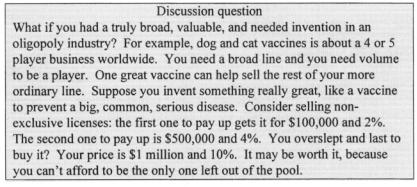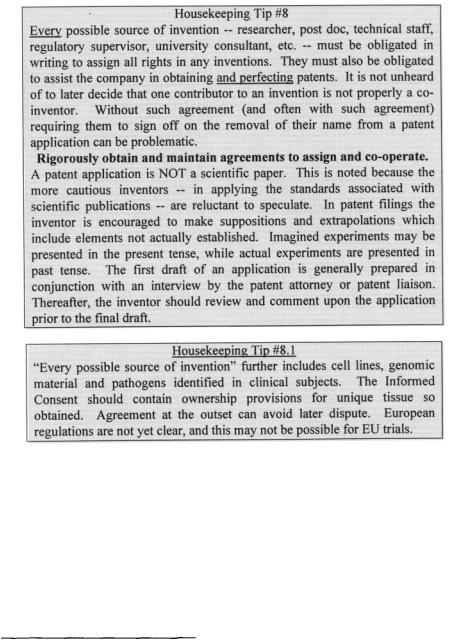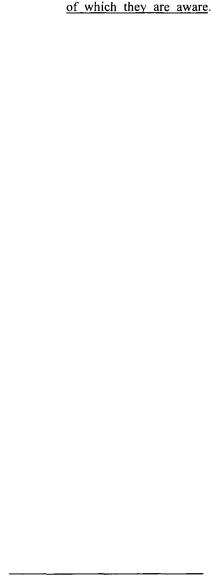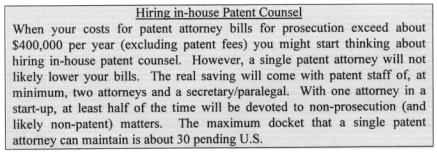
Engineering and Manufacturing for Biotechnology - Marcel Hofman & Philippe Thonart
.pdf
Translating European biotech into US patents do’s, don’ts, & costs
vast market? Many, perhaps most, inventors want control and exclusivity when, in fact, reasonably cheap non-exclusivity to any and all comers is most profitable. One favourite example is the Dolby noise reduction system. Dolby could never have overcome the Sony's and Panasonic's making cassette player-recorders. But at about a 1% royalty on a non-exclusive basis, even the sleaziest knock-off artists in the world will take a license and pay the royalties. Following this patent strategy, Mr. Dolby is now richer than most biotech executives are.
6.3.4. More patent strategy, packages II
It’s not rocket science to identify and assemble a licensable patent/patent application package. But it is sometimes cosmology, astrology, pure guesswork, or intangible management skill as to what a BigPharma executive will buy from you and when. No matter what you have, it must appear to be something on their list, and it must arrive when they are in the mood to make a deal. Timing counts and luck counts double.
It helps to have that certain "je ne sais quoi" which is French for how is it that Ligand, Onyx, Arris, and Millenium can do this again and again and again and my product is years closer to the market and I can’t get a partner? Other companies have great science and great people too, but the aforementioned seem to have an exceptional ability to turn it into the big deal. Take heart: simple products ready for market are rarely bought by big licensors, but they can make you a very nice living.
7. Filing a patent application
7.1. INPUT FROM THE INVENTOR
Filing a patent application requires providing the patent attorney with information. This is not a simple task, and an inventor must be prepared to commit the necessary time to adequately collect and supply information. Preparing a patent application is not like stopping by the photo shop to pick up developed pictures from film you dropped off earlier.
469

Thomas M. Saunders
All of the available data should be provided. A full description of what the invention does, how this is accomplished, everything it might do, and the significance of the discovery is necessary. Often, this requires that the inventor perform calculations of ranges or working conditions, or calculated distinctions over the prior art.
7.2. MORE INPUT FROM THE INVENTOR
Failed experiments and contrary information must be provided. Hiding such information merely provides grounds for invalidating a patent should one issue and the product succeed. The best mode of practising the invention must also be provided.
Patent sophisticated inventors know the advantages of being forthcoming (and make the patent attorney appear infinitely smarter). Unsophisticated inventors are hazardous to patent and patent attorney health. You’ve seen it on the crime shows, and believe it here: It is a mistake to lie to or mislead your attorney.4
4Of course, having been down this road, we rarely believe anything without extensive grilling.
470

Translating European biotech into US patents do’s, don’ts, & costs
7.3.COMPILE ALL RELEVANT ART
7.3.1.Why
A European patent applicant has no specific requirement to inform the European Patent Office of significant prior art. In the US there is a duty of absolute candour. In US practice, patent applicant -- inventor and company -- as well as patent counsel have a clear obligation to inform the Patent Office of any relevant art which is material to an
invention |
This is done in the context of providing an |
Information |
Disclosure Statement and, as necessary, supplementary Information |
Disclosure Statements. Technically (and isn’t that why we are here) the required information is information published prior to the filing date of the application.
However, as noted before, be forthcoming with patent counsel.
Wholeheartedly fulfilling the disclosure obligation is a particular responsibility of the inventor. Failing to fulfil this obligation can result in an invalid or unenforceable patent. The two best reasons to rigorously meet the requirement are (a) if there is any way to distinguish your invention over the prior art causing concern it can most easily be established in argument during patent examination5, and (b) once the PTO has passed on a reference it is dead as a validity problem. A corollary is that, recognising the litigation prone nature of US biotechnology, any reference not disclosed will be characterised by an opponent as a clear effort to mislead the Patent Office and defraud the public. As Europe permits patent oppositions prior to patent issue, significant references will likely to be considered in Europe, even without a Duty of Disclosure.
Finally, as to housekeeping matters, make at least five notebooks of the art you compile. Additional sets are always required somewhere down the line. This task is made easier by maintaining a current company-wide filing system/database of references. Computer programs such as “Endnote” are available for this purpose. The alternative is searching each office for references with the filing of each patent application.
7.3.2. Yes, everything
In fact, it can be quite a substantial job to thoroughly present all relevant art of which one is aware. Consider art
7.3.2.1.Cited in related applications. Always present all art cited the application being filed and in related applications (including international versions).
7.3.2.2.Materials consulted in application preparation. Any journal articles or patents specific to the new application and consulted during its preparation must be considered for presentation to the PTO.
7.3.2.3.Reading files. Most scientists keep a rather extensive reading file in their area
of research. These articles have typically been gathered over years and occupy several
5 If you can’t beat up the PTO, who can you beat up?
471
Thomas M. Saunders
file drawers in the inventor’s office. The files must be consulted, and relevant papers selected. It is a good practice to stand there while the scientist/inventor goes through the files. When you do, listen closely for those "sotto voce" remarks like “I don't know about this one?” React, seize the reference, and over include. [  It really does happen just this way.]
It really does happen just this way.]
7.3.2.4.Computer runs. If a database was consulted and a number of abstracts reviewed, a copy of the computer run must be presented.
7.3.2.5.Company library. If there is a central patent and articles file for the entire company to which the inventor has access, some consideration must be given to what
the library contains.
7.3.2.6. Don’t under present. An inventor must be cautious and over present to patent counsel. Failure to do so looks like concealment, while complying effortlessly shifts responsibility and later blame to counsel. Its easy, it's fun.
7.3.3. When
The prior art need not be submitted with the application. It can be submitted up to about 3 months later, and is presented as an Information Disclosure Statement. Somewhat later and for a few months, it can be submitted along with a $200 fee. But who’s kidding whom? If it's not done immediately, when do you think anyone will get to it?
7.3.4. Searches
It is not a usual practice to search the literature in advance of filing a patent application for the purpose of determining if subject matter is patentable. It is simply not cost effective. First, your researchers in the field are aware of what is known in their own field. Second, as a company is filing multiple applications in a single technology, the usual obstacles are usually known. Thus, if the composition or method of interest is clinically effective, and the identical product or method is not in use, it is likely that there is a patentable aspect to the effective approach, and the search step will not alter this.
8.The prior of prior art
8.1.IN THE US
Prior art is the public use or sale or the publication of aspects of your invention before your earliest filing date for the relevant subject matter. Thus, if in Patent Application A you disclose Composition A, and the application is filed February 1, 1996, disclosure of Composition A prior to February 1, 1996 is prior art. If, on August 1, 1996 you file a continuation-in-part application (“CIP”) of the original application adding new matter.
472

Translating European biotech into US patents do’s, don’ts, & costs
The addition of new matter is the defining characteristic of a CIP. In the present example the new matter of the CIP is the disclosure of0 Composition A’. The CIP is subject to prior art existing prior to August 1, 1996 as to Composition A’, but for Composition A, the prior art date remains February 1, 1996. As explained more fully below, there is an opportunity to “swear behind” a reference that is within one year of your filing date.
The effective date of a publication is calculated from the date the publication first arrives in the hands of a member of the public, and not the date printed on the publication. For example, a newsmagazine like Time is published, perhaps, a week before the date listed on the magazine, but the effective date is the date it hits the newsstands.
The effective date of an issued patent acting is its earliest filing date; not its issue date. Of course, if the issued patent is a CIP of earlier applications, one must look to each parent application to determine the earliest date at which specific new matter is disclosed.
8.2. NON-US
There is no CIP practice outside of the US. Thus, in Europe and elsewhere one is regularly faced with distinguishing your early patent application from the later CIP applications. While this is frustrating for obtaining patents, it presents a cost saving opportunity. If the first application is allowed, and in truth the distinctions between Composition A and Composition A’ are slight, drop the second application and save the money.
9. Making U.S. filings/incurring
9.1.APPLICATION PREPARATION
9.1.1.New applications
To properly prepare a patent application, a patent attorney must devote about 6 to 8 weeks to drafting, at minimum. This minimum time period presumes that the inventors make themselves available to respond to questions, supply additional information as
requested, and promptly read and comment upon drafts of the application. |
Legal fees |
for preparation of a biotech application start at about $10,000. There is a |
basic filing |
473

Thomas M. Saunders
fee of $385 for an individual, non-profit, or small entity and double that for a large entity. Additional fees are required when a basic number of claims is exceeded, but in the U.S. this is usually only a few hundred dollars at most. In Europe the excess claim fees are very large, but different claim provisions permit a reduction in claims for European filings.
9.1.2. Provisional applications
U.S. law now provides for the filing of a “provisional” patent application. A provisional application differs from the usual application in that there are virtually no formal requirements to obtain a filing date. Within one year from filing a provisional application, the provisional application can be converted to a regular patent application.
Conversion of a provisional applications to regular applications must be done within one year, and cannot extend to the next business day if the anniversary date falls on a Saturday, Sunday or Federal Holiday. The filing fee is $75 for a small entity and $150 for a large entity. If there is neither a US inventor nor US corporation involved,
Provisional Applications are uncertain because, when the PCT application is filed it cannot be initially filed through the US receiving Office. Then, as the PCT application is not derived from a regular application may have a questionable priority.
9.1.3. Later applications
U.S. patent applications are regularly refiled exactly as originally filed, or refiled only slightly amended. Refiling occurs when one has not obtained allowed claims during the limited periods in which one can argue the merits of the application, amend the claims, or offer additional evidence to the Patent Office. In many instances, the Patent Office finds that multiple separate inventions are being sought within a single application. In such a case, the Patent Office enters a restriction requirement forcing the applicant to elect one invention. The non-elected inventions are then pursued in separate applications.
To keep up with the jargon, a re-filed application is called a “continuation” or “straight continuation” application. If some claims were not examined in the original application, the continuation is called a “divisional” application. If, at the time of refiling a continuation application, one wishes to pick up prosecution where the parent application left off, the filing is called a “file wrapper continuation” or FWC.” If  new matter is added, the continuation application is called a “continuation-in-part” application (“CIP”).
new matter is added, the continuation application is called a “continuation-in-part” application (“CIP”).
474
Translating European biotech into US patents do’s, don’ts, & costs
9.2. PATENT PROSECUTION
9.2.1. First matters
After a patent is filed, the applicant awaits action from the Patent Office. There is often some early activity as to ministerial matters, which incur minor costs. Such matters include the filing of a declaration by the inventors that they invented the subject matter of the application. It is not unusual for a declaration to be omitted in the last minute rush to file. Similarly, an assignment of the invention to the company may come later, as will formal drawings. Formal drawings are figures prepared by a draftsperson according to Patent Office rules.
9.2.2. Information disclosure statement (cont.)
As noted above, one item early item is the Information Disclosure Statement, which is to be filed within about 3 months after the original filing, if not with the original filing.
9.2.5. First office action
Under normal circumstances, and depending on the backlog in the section of the Patent Office to which your application is assigned, a first Office Action on the merits for a new patent application will come in about 12 to 18 months. A continuation or divisional application may receive a faster first Office Action. There are provisions whereby an application can be “made special” and advanced more quickly through patent examination. Given the regulatory delays attendant to pharmaceutical production, this seldom makes sense. Nevertheless, an issued patent may be of interest to unsophisticated inventors, or if a competitor is about to market a product your patent could block.
Except in unusual circumstances, applications are presented with claims to insure an initial rejection of the broadest claims. The thinking is that if the applicant secured a first Office Action allowance, and did not “over-claim” then the invention had not been claimed broadly enough at the outset.
9.2.4. First response
A response to an Office Action is due three months from the mailing date by the Patent
Office. A response can be extended in monthly increments up to six months from the mailing date of the Office Action (that is up to 3 months of extension). The Patent
Office motto is “If you’ve got the money, we’ve got the time.” While a one-month extension is only $55 for a small entity, the full three months costs $465 (and double for a large entity). Legal fees for responding will run several thousand dollars.
At this point it is possible to amend claims and to offer supporting data. Later in prosecution, this will not be possible. It is also possible to interview the Examiner and urge the merits of the application. Interviews can be via telephone or in person at the Patent Office. In some instances, an inventor may participate in the interview.
For the best results, your inventors should be available to assist counsel in responding. In fact, this should not prove particularly onerous. A portfolio of patent
475

Thomas M. Saunders
applications involves substantially the same references. Thus, after the first few responses in an area, all the art applied by the Patent Office will be known and the distinctions over the claimed subject matter, well defined.
Occasionally, more will be required of an inventor or corporate technical staff.
9.2.4.1. Swearing behind. In some instances, to avoid a reference with an effective date of publication within one year or less from the filing date of the application, an inventor will be asked to “swear behind” such a reference. In practice, this means that if the patent were filed on April 1, 1996, and the reference were dated March 1, 1996, then the inventor is permitted to file a declaration, and likely, some pages of a lab book, establishing that the information in the reference was known by the inventor prior to March 1, 1996. If the reference is over one year prior, there is no swearing behind
9.2.4.2. Expert Opinion. A declaration can be filed under other circumstances as well. When a calculation can be performed that distinguishes claimed subject matter from a reference, a declaration is the better way to offer such calculations (as distinguished from “mere attorney’s arguments”). For example, a reference may state a particular concentration of reagents, but not state the pH, while the rejected claims are limited by pH. An inventor or other expert could offer a calculation that establishes that the pH of the reference could not overlap the claimed subject matter.6 Similarly, an expert could offer an opinion as to what “one skilled in the art” (the standard measure) would have understood from a reference or a term. If a relative term such as “high dosage” appeared in a reference, and the claims were drawn to a some µg/ml or ng/ml dosage, would that have been understood by one skilled in the art as of the filing date to include the claimed subject matter? An expert could offer the view that these amounts were orders of magnitude apart.
9.2.4.3. Specific Comparative Experiments. It is possible to provide comparative test results as a means to establish patentability. This is a less favoured course for several reasons. In general, comparative experimental evidence is highly peccable. While the Patent Office may be satisfied, it offers a substantial point of attack in litigation. Also, the result may be other than what was hoped for.
There is also the question of the need for any specific comparisons. In biotechnology, if the drug works, and it has not been produced before, and the FDA is going to be satisfied, then the data required to establish patentability is out there or will be prepared in the normal course of business. Await this data. Doing experiments to satisfy a patent attorney is usually counterproductive and an inappropriate use of corporate resources.
6One must be cautious, as an error in calculation could be viewed as an attempt to mislead the Patent Office.
476
Translating European biotech into US patents do’s, don’ts, & costs
9.2.3. Further office actions and responses
The next Office Action on the merits either allows some claims, or (and more usually) presents a Final Rejection. A second non-final Office Action may be sent. If the second response is not a final rejection, it usually means that the applicant’s arguments prevailed, but the Examiner is citing new art as the basis for rejection. If final rejection is received, there are several options.
While six months to respond is available (with extension fees); the first option is to respond within two months offering further argument. A quick response requires the Examiner to promptly issue yet another Office Action. Otherwise, the Examiner need not respond in a timely fashion. At this point, the ability to amend the claims is rather limited. The only amendments usually accepted are those to bring the claims into accord with what the Examiner will allow. New claims and new data will not be considered. Also, the Examiner can always be contacted. While the Examiner is not required to discuss an application under final rejection, a refusal to discuss an application is rare.
Whenever the final rejection is truly final, the prosecution options are to refile or to appeal to the Board of Appeals. An appeal comprises filing a Notice of Appeal, and, two to six months later, an Appeal Brief. Thereafter, there is the opportunity for a Reply Brief, as well as the option of oral argument before the Board of Appeals. The Board of Appeals is comprised of three senior Examiners. Given the variability of patent Examiners, the technical expertise of the Board often leads to a reverse of illogical final rejections.
The briefing required for an appeal can run about $7,500-15,000, (if the briefs are actually filed). An appeal will not be decided for several years. In most instances, and with additional data usually in the offing, the more effective course is to refile the patent application. Selecting between appeal and refiling is fact specific. Assessment can only be made with attention to the patent application, the actual rejection, the data available, and the market situation at the time of decision. In any event, the decision to appeal can later be countered simply by dropping the appeal and refiling. As noted below, when data is expected in the near tem, extensions for responses and filing notices of appeal can be made for reasons of increasing the time available.
9.4. MAINTAINING PENDING APPLICATIONS
No matter how many patents have issued on your technology, it is important to keep an application pending in the US on subject matter that will become a product. If a patent has issued and there are no pending applications, the options to modify an issued patent are limited to either patent “re-examination” or “re-issue.”
9.4.1. Re-examination
“Re-examination” is a process that permits the US Patent Office to review issued patents in view of newly presented prior publications. Previously, the law permitted anyone -- even anonymous “third parties” -- to request re-examination. Under the old system, after requesting re-examination, a third party had little voice. As a method of attacking a patent, the chief virtue of re-examination was that it was a great bargain as
477

Thomas M. Saunders
compared with patent litigation. Under the new law, a party opposing a patent by re- examination has a voice in the entire proceeding.
Europe has longs had a system for opposing patents before the European Patent Office. For nine months after a patent issue in Europe, anyone can oppose the patent. The change in US law brings something like the opposition system to the US
Under the new US re-examination system (i) anonymous third parties are excluded, (ii) the opposer can argue against the patent at every step, and (iii) the results of reexamination are binding on the parties in any later infringement suit. This provision effects patents filed after November 29, 1999.
Without regard to imminent litigation, a patent holder is permitted to request reexamination if the patent holder finds a significant reference not previously considered. Re-examination is, at best, cumbersome. If there is a pending application, it is a simple matter to cite the reference to the Patent Office and argue it in the context of that pending application. While this does not absolutely dispose of the reference as to prior issued patents, a successful distinguishing argument in a pending application will clearly defuse the reference as a point of weakness in the issued patents.
9.4.2. Reissue
In an issued patent claims cannot be easily expanded, but, insofar as permitted, this is accomplished by “reissue.” Claim expansion is sought when the patentee discovers that, through inadvertence, less has been claimed than might have been claimed. Such inadvertence often arises right after seeing a competitor's product. Even the limited right to increase claim scope is absolutely ended two years from issue.
9.4.3. Pendency
Maintaining a pending application is largely a matter of refiling the application and including new subject matter, or, while waiting later developments, pursuing rather narrow (but not frivolous) claims. Given six months to respond to each Office Action, and the availability of an additional six months based on a notice of appeal, a follow on application can run at least two years with minimal expense.
478
